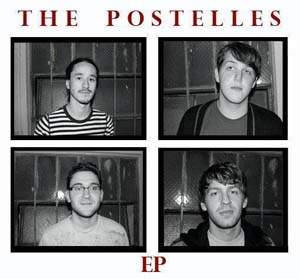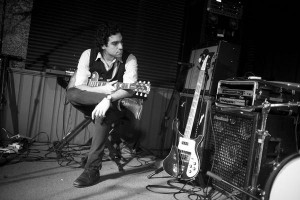The Postelles Get St(r)oked for Their Upcoming Debut Album
UPPER WEST SIDE: From the land of mediocre restaurants and mid-life crisis, the Upper West Side, come The Postelles. How did this foursome rise above the cultural obstacles of their upbringing, coming from a place where the Gap and Starbucks reign as supreme as in the Topeka suburbs, to make their own ear-tingling brand of rock?

There are four of them.
It starts with their pure and simple influences, drawing off of resources that range from Motown to the Strokes, Buddy Holly and the Beatles. As a result, their upcoming self-titled debut due out on July 27th on Astralwerks/Capitol Records is due to get its own notice from the lo-fi, upbeat crowd.
The four-piece squad of 21/22-year-olds, Daniel Balk (lead vocals, guitar), David Dargahi (lead guitar), John Speyer (bass) and Billy Cadden (drums), co-produced the 11-track album with Albert Hammond, Jr. of the Strokes. One listen to jangly tracks like “White Nights” (available as a free download from the band’s site), and it’s no mystery why band and producer were a royal fit.
The record may have been made in two chunks – one under the supervision of Sr. Hammond, Jr., the other without – but it comes together as one big burnin’ hunka New York City rock ‘n’ roll. Appropriately, we grilled Daniel Balk about it.
Q: So the recording of this record was a “half-and-half”? Explain.
A: This is how it worked out: We did the first half with Albert and Gus Oberg, who engineered it, at Looking Glass Studios, and I think we were the last band to record there. We did five songs in 14 days, which is the way we usually record.
We learned a lot from that phase. Albert really taught us a lot about how to record. So the next half we did at Quad — eleven songs in three days. We came in at 11 AM and stayed until 4 AM every day.
Q: You said you learned a lot from Albert – like what?
A: I play guitar, and David also plays lead guitar. Albert taught us a lot about getting the right tone, like how you can change it by turning the treble down for the verse and up for the chorus. We usually just plug in and play, and we still do, but now we can do a lot more than that.
David more uses so many pedals and I don’t use any, but speaking for him he would say his favorite pedal that he learned about from Albert and Gus is the Jeckyll and Hyde overdrive pedal. If you’re going to be a lead guitarist, and want a dirty sound but not too processed, that’s the best pedal around, for sure. I know the Strokes use it, and they have some of the best sounds around.
Q: How come no pedals for you? I thought all guitarists hearted pedals.
A: It could be a little bit of laziness. But its more so that I really love the early Beatles, Buddy Holly, even the Stones, early on. If you look at them live, they don’t have any pedals. I love the sound of the guitar plugged into the amp without anything else coming in.
Dave’s doing solos, changing sounds, so he has to do that. But for me, I didn’t want to fuck around with it too much. I love that raw sound. I don’t think it’s anything too crazy. On the album, the amp I played through was a Peavey Classic from the late ‘70’s/early ‘80’s. I played a white Stratocaster, and I also played a Gretsch Penguin.
For the drum sounds, Gus and Albert spent six hours a day on drum sounds. For the song “Hold On,” we put a few napkins on the snare drum to deaden the sound, and that sounded really cool. We also spent a lot of time on bass.
Q: That’s funny, because when you think of the Strokes, their most famous records have a reputation for being lo-fi, i.e. not spending a lot of time…
A: I thought that, too. But Albert’s a perfectionist. The second time we recorded (at Quad) it was more like that – faster — but not in a bad way. It was more like we knew what we were recording.
Q: Why were you working with Albert Hammond, Jr., in the first place?
A: He saw us in a club called Sidewalk Café. He was nice enough to come in, sort of liked us, and we did a demo in his bedroom.

Albert Hammond, Jr. (Photo credit: Justin Jay)
When it came time to do the album, he had never really produced anything except his own work. He said, “I’d love to do it,” and it was a no-brainer. We were good friends, and Is This It is one of my favorite records ever. The label threw out a lot of big producer names — we met a lot of people, and it didn’t feel right. We wanted to work with someone we respected and got along with also.
Q: Once everything got going, was there a deliberate sound that you’re going for there?
A: We didn’t want it to sound like a huge album — we’re not an arena rock band. We also didn’t want it to sound like a demo. We wanted to go in between, and have a retro kickback sound that no one has nowadays. We wanted to get that across.
Our big thing is recording live. We wanted to not overdub, and do all the instruments playing together, like the Strokes, the Ramones, the early Beatles.
We did do a few overdubs, naturally. We definitely heard things a few days later like “Holy shit, we have to redo that vocal!” Obviously, we didn’t do the harmonies live, because no one’s perfect.
[At this point, someone on Daniel’s end asks him if he wants a sandwich].
Yeah. Turkey, swiss, mayo.
We think harmonies really build up a song. Going back to Motown, doo wop groups – we love the way that sounds. That has to be perfect, and we’re not the Temptations.
Q: Yes, you are the Postelles. So why wasn’t Albert producing for the album’s second half?
A: We went into the first half saying we had songs we wanted to do. Then after those were recorded we got back into writing, and he was doing some touring and it didn’t work out.
It ended up perfectly, because everything we learned from him in the first half we took into the second half. We had a great engineer at Quad named Robert Dorsey, and he really helped us out a lot.
Q: What are some songs from each recording chunk where you feel like everything really came together?
A: The most fun song from the first half was “Hold On”, a slow song. I think we did one take and nailed it. We really like that, getting it done. I think it came out the best.
In the second half, I think maybe the song “Can’t Stand Still.” It came out really well – it’s the newest song on the recording. I didn’t play guitar on it. It was fun to do the vocals and not worry about the guitar.
Q: Right on – we’re looking forward to hearing the whole album when it drops in July. Until then, why do you think people are digging on the Postelles?
A: There’s a lot of bands nowadays from Brooklyn with seven synthesizers or whatever. But I think a lot of band now are doing it just to do it, because it’s cool. With us, I think people find comfort in going back to the old bands, where they just plugged in and played without backing tracks. I hope people appreciate it. I like just going up, playing, and not having to worry about all these wires everywhere. — David Weiss
Please note: When you buy products through links on this page, we may earn an affiliate commission.






